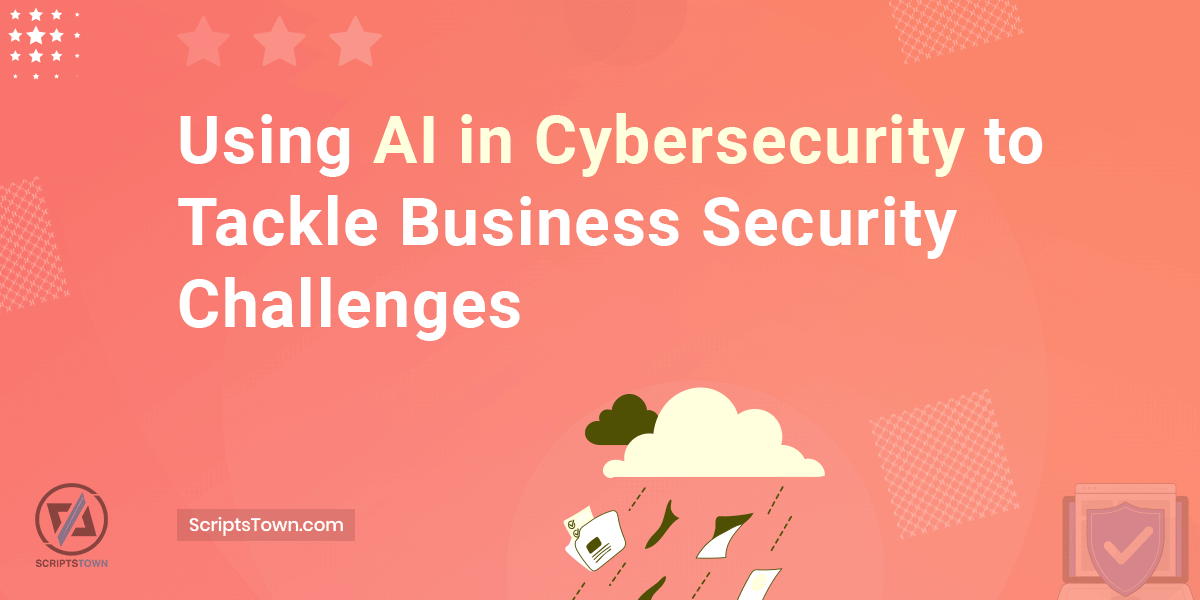Cybersecurity is a significant concern for businesses of all sizes, as cyberattacks can result in irreparable damage, financial losses, data breaches, and reputational damage. Generative AI technology adds a new layer of complexity, making these cyberattacks more sophisticated and widespread. Traditional cybersecurity methods are often insufficient to keep up.
In this article, you’ll learn the role of AI in addressing complex cybersecurity challenges. The article explores how AI can reduce skill gaps required for cybersecurity and how a business can utilize an AI-powered cybersecurity solution to effectively and efficiently secure its data, networks, and applications. Furthermore, it explores security practices with AI to follow and the challenges of adopting AI for cybersecurity.
The Need for AI in Cybersecurity
One of the main challenges cybersecurity professionals face is the overwhelming volume of data generated by various security products, such as email, web, network, and endpoint protection systems. It is a daunting task to manually analyze and correlate this vast amount of data, resulting in missed threats and delays in threat detection and response times.
An AI-based cybersecurity solution can:
- Analyze large datasets and identify patterns far beyond human capabilities.
- Detect anomalies and patterns that human analysts might miss.
- Provide actionable insights through intuitive dashboards and detailed threat analytics.
- Secure cloud environments by responding to suspicious activities dynamically.
- Automatically learn from data, adapt, and make intelligent decisions to identify and mitigate threats proactively.
AI and machine learning algorithms can assist in automating data correlation and anomaly detection processes. AI-powered security tools can analyze and process vast amounts of data in real-time to identify patterns and anomalies that may indicate potential threats. This proactive approach helps businesses to detect and mitigate cyber threats before they can cause significant damage. It is prevention rather than reactive detection and response.
Addressing the Cybersecurity Skills Gap
The cybersecurity industry faces a significant skills shortage, making it challenging to find and retain qualified professionals. Leveraging AI-powered solutions can help bridge this skills gap by making security more accessible to diverse backgrounds.
- AI-based security solutions can help organizations extend their cybersecurity workforce.
- Organizations can implement AI-based security validation tools to objectively assess team capabilities, identify specific skill deficiencies, and develop improvement plans.
- AI tools with built-in expert knowledge empower less experienced staff to efficiently handle complex tasks with accuracy and confidence.
- AI can automate tasks and augment the human capabilities of existing security teams by automating mundane and repetitive tasks such as log analysis, event monitoring, and routine policy configuration. This enables security professionals to focus on higher-level security tasks that require human judgment, strategic planning, and creativity.
Moreover, AI can assist in training and upskilling cybersecurity professionals by providing simulated environments for hands-on learning and scenario-based training. This approach improves the skills of existing personnel and also helps to attract and retain talent in the cybersecurity field.
AI-Powered Security Solutions for Business Security
To integrate AI into cybersecurity strategies, careful planning and execution is required.
The following are essential considerations when implementing AI-powered security solutions for business security:
- Security needs assessment: Conduct a thorough evaluation of your organization’s security requirements to determine where AI can provide the most value.
- Data quality and integration: Ensure that data sources are accurate, up-to-date, and integrated across systems to maximize the effectiveness of AI algorithms.
- Training data models: Train AI models with high-quality data sets that reflect diverse threat scenarios to enhance accuracy, adaptability, and reliability.
- Collaboration with IT teams: Promote collaboration between cybersecurity experts and data scientists to develop tailored AI solutions that align with security objectives.
- Compliance and regulatory alignment: Implement measures to ensure AI-powered security solutions comply with relevant regulations and industry standards.
- Continuous performance evaluation: Implement a robust framework for continuous monitoring and evaluation of AI system performance. Enable timely adjustments and enhancements to maintain a proactive stance against evolving cyber threats.
- AI skill development initiative: Invest in comprehensive training programs to equip IT staff with the skills and knowledge required to effectively leverage AI security tools.
AI-Powered Threat Detection and Alerts
An AI-powered threat detection system can:
- Identify anomalies: AI algorithms can establish baselines for normal system behavior and flag deviations that could indicate a potential threat. Anomaly detection can use dynamic methods to analyze real-time activity logs, identifying deviations from typical network or system behavior with high precision.
- Correlate events: AI can correlate seemingly unrelated events and identify patterns that may indicate an ongoing attack campaign.
- Prioritize alerts: Based on the severity and potential impact of threats, AI can prioritize alerts, allowing security teams to focus on the most critical issues first.
- Provide contextual insights: AI systems can automatically gather and analyze relevant context around a potential threat, such as affected assets, user behavior, and historical data. This can help analysts make faster and more informed decisions.
- Enhance threat awareness: AI can synthesize data from multiple sources, including global threat feeds, to provide actionable insights and identify new attack vectors.
- Identify zero-day threats: AI can detect unusual behavior or code signatures that could indicate unknown, zero-day vulnerabilities before they are exploited. It can also autonomously scan networks and systems for signs of dormant threats.
Example: An AI-powered security solution can analyze network traffic patterns and user activity logs to detect suspicious activity. This can be unauthorized access attempts or data exfiltration. It can then automatically trigger incident response protocols, such as blocking malicious traffic, isolating the affected systems, and alerting security personnel for further investigation and remediation.
Furthermore, to fully leverage the power of AI in cybersecurity, businesses should consider integrating their security products into unified platforms with a single policy engine and data correlation capabilities. This integration simplifies security policy management and enhances threat detection and response efficacy by enabling seamless data sharing and analysis across multiple security solutions.
Addressing AI-Specific Threats
As businesses adopt AI in their cybersecurity strategies, they must also be aware of AI-specific threats. These include adversarial machine learning attacks, model theft attempts, and prompt injection vulnerabilities.
Adversarial Machine Learning Attacks
Adversarial machine learning attacks aim to deceive or manipulate AI models by introducing carefully crafted inputs or data points. These attacks can cause AI systems to misclassify inputs, leading to false positives or false negatives, and potentially compromising the security solution. Develop robust AI models and implement defensive measures, such as adversarial training and input validation to mitigate these threats.
Data Poisoning Attacks
Data poisoning attacks involve injecting malicious or corrupted data into the training dataset used by AI models. This can lead to biased or incorrect decisions by the AI system. As a result, this can undermine its effectiveness and potentially introduce security vulnerabilities. Implement secure data pipelines, data validation techniques, and monitoring mechanisms to detect and prevent data poisoning attacks.
Furthermore, establish data governance practices like data provenance tracking, version control, and access controls, to ensure the integrity and trustworthiness of training data.
Model Extraction and Inversion Attacks
These attacks aim to extract or reconstruct the underlying model or training data used by an AI system. This can potentially expose sensitive information or enable model replication. Implement robust access control, encryption, and secure model deployment practices to mitigate these threats.
Prompt Injection Vulnerabilities
Prompt injection vulnerabilities occur when an AI system’s input handling mechanism fails to properly sanitize or validate user-provided prompts or inputs. This can allow an attacker to inject malicious code or commands into the AI system. As a result, this can potentially lead to data leaks, unauthorized access, or system compromise.
To address prompt injection vulnerabilities, implement the following measures:
- Input validation: Implement strict input validation mechanisms to sanitize and filter user-provided prompts. Remove or escape any potentially malicious code or characters.
- Secure prompting: Design and implement secure prompting mechanisms that enforce strict rules and constraints on the format and content of user-provided prompts.
- Prompt isolation: Isolate and sandbox the execution environment for processing user prompts. Limit the potential impact of a successful prompt injection attack.
- Monitoring and logging: Implement comprehensive monitoring and logging mechanisms to detect and respond to prompt injection attempts or suspicious activities.
- Regularly update and patch AI systems and their underlying components to address known prompt injection vulnerabilities and other security vulnerabilities.
Improving Security Practices with AI
AI can help improve security practices in businesses. One approach is to use AI in phishing detection to identify and block fraudulent emails.
AI can also help automate compliance checks with regulatory requirements by continuously monitoring and reporting on security controls.
Risk Assessment and Vulnerability Management
AI can help organizations assess and quantify cyber risks by analyzing various factors, such as threat intelligence, vulnerability data, and business impact.
Example: An AI-powered risk assessment tool can analyze an organization’s asset inventory, vulnerability data, network configuration, threat intelligence, and industry-specific regulations to provide a comprehensive risk score. This score can help prioritize remediation efforts and ensure compliance with relevant security standards. The AI tool can also provide actionable recommendations based on the risk score.
Moreover, an AI-powered vulnerability scanner can analyze applications, systems, and networks more thoroughly. It can identify potential vulnerabilities that traditional scanners may miss. AI can also prioritize vulnerabilities based on their severity and potential impact.
Security Awareness and Training
AI-powered phishing simulations and interactive training modules can help educate employees on recognizing and responding to cyber threats.
Furthermore, AI can assist in developing personalized security awareness and training programs. It can identify knowledge gaps, analyze user behaviors, and tailor content accordingly. This targeted approach improves the effectiveness of security awareness programs within the organization.
Challenges in Adopting AI for Cybersecurity
AI offers significant benefits for cybersecurity but its adoption also presents several challenges that organizations must address.
One major challenge is evaluating the accuracy of AI-powered solutions and ensuring that they do not generate false positives or negatives. Another challenge is ensuring that the AI models used in cybersecurity are transparent and interpretable. This is necessary to understand how the models make decisions and to detect and correct any distortions.
Here are some other challenges in adopting AI for cybersecurity:
- Data quality and availability: AI models require large amounts of high-quality data for training and effective operation. For organizations with limited resources, it could be challenging to obtain and maintain relevant, accurate, and up-to-date security data.
- Integration, deployment, and scalability: Integrating AI-powered security solutions into existing security infrastructure and processes can be complex and time-consuming. Deploying AI requires significant upfront investment in infrastructure and training, which can strain budgets, especially for smaller businesses. Furthermore, it can be challenging to ensure scalability and performance as the volume of data and threats increases.
Conclusion
Despite the challenges, the potential benefits of incorporating AI into cybersecurity practices are substantial. AI’s ability to learn and adapt provides businesses with a formidable line of defense against cyber attacks.
The use of AI in cybersecurity can help businesses detect and respond to threats more effectively, address the cybersecurity skills gap, and improve security practices. An effective collaboration between security professionals, AI researchers, and industry stakeholders is crucial for the integration of AI into business cybersecurity strategies.
Furthermore, we have a comprehensive guide on various applications of AI in business to drive growth and improve efficiency.









